
In folklore, a ghost is the soul or spirit of a dead person or non-human animal that is believed to be able to appear to the living. In ghostlore, descriptions of ghosts vary widely, from an invisible presence to translucent or barely visible wispy shapes to realistic, lifelike forms. The deliberate attempt to contact the spirit of a deceased person is known as necromancy, or in spiritism as a séance. Other terms associated with it are apparition, haunt, haint, phantom, poltergeist, shade, specter, spirit, spook, wraith, demon, and ghoul.

Newgate Prison was a prison at the corner of Newgate Street and Old Bailey Street just inside the City of London, England, originally at the site of Newgate, a gate in the Roman London Wall. Built in the 12th century and demolished in 1904, the prison was extended and rebuilt many times, and remained in use for over 700 years, from 1188 to 1902.

The Wild Hunt is a folklore motif occurring across various northern European cultures. Wild Hunts typically involve a chase led by a mythological figure escorted by a ghostly or supernatural group of hunters engaged in pursuit. The leader of the hunt is often a named figure associated with Odin in Germanic legends, but may variously be a historical or legendary figure like Theodoric the Great, the Danish king Valdemar Atterdag, the dragon slayer Sigurd, the Welsh psychopomp Gwyn ap Nudd, biblical figures such as Herod, Cain, Gabriel, or the Devil, or an unidentified lost soul either male or female. The hunters are generally the souls of the dead or ghostly dogs, sometimes fairies, valkyries, or elves.
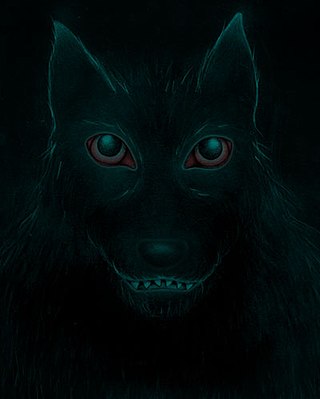
In English folklore, Black Shuck, Old Shuck, Old Shock or simply Shuck is the name given to a ghostly black dog which is said to roam the coastline and countryside of East Anglia, one of many such black dogs recorded in folklore across the British Isles. Accounts of Black Shuck form part of the folklore of Norfolk, Suffolk, the Cambridgeshire Fens and Essex, and descriptions of the creature's appearance and nature vary considerably; it is sometimes recorded as an omen of death, but, in other instances, is described as companionable.

Thomas Lyon-Bowes was the first child of Thomas Lyon-Bowes, Lord Glamis, and his wife Charlotte Lyon-Bowes née Grimstead, great-grandparents of Elizabeth Bowes-Lyon, who became queen consort in 1936. Although Thomas is recorded in Robert Douglas' Peerage of Scotland as "born and died, October 21, 1821," rumours began to circulate during the late 19th century that the child had been born deformed, and had therefore been brought up in seclusion hidden away in Glamis Castle in Angus, Scotland, giving rise to the soubriquet of the Monster of Glamis, or the Horror of Glamis.
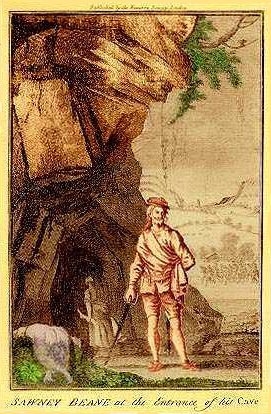
Alexander "Sawney" Bean is a legendary figure, said to be have been the head of a 45-member clan in Scotland in the 16th century that murdered and cannibalised over 1,000 people in 25 years. According to the legend, Bean and his clan members were eventually caught by a search party sent by King James VI and executed for their heinous crimes.
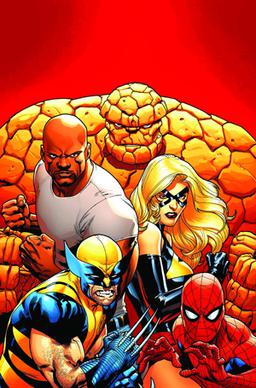
The New Avengers is a fictional team of superheroes appearing in American comic books published by Marvel Comics. The title has been used for four American comic book series. The first two were written by Brian Michael Bendis and depicted a version of Marvel's premiere superhero team, the Avengers. The third was written by Jonathan Hickman and depicted a group of characters called the Illuminati. The fourth is written by Al Ewing and depicts the former scientific terrorist group A.I.M., reformed as "Avengers Idea Mechanics", whose field team has appropriated the name "New Avengers" for itself.

A hellhound is a mythological hound that embodies a guardian or a servant of hell, the devil, or the underworld. Hellhounds occur in mythologies around the world, with the best-known examples being Cerberus from Greek mythology, Garmr from Norse mythology, the black dogs of English folklore, and the fairy hounds of Celtic mythology. Physical characteristics vary, but they are commonly black, anomalously overgrown, supernaturally strong, and often have red eyes or are accompanied by flames.
Wentworth Smith, was a minor English dramatist of the Elizabethan period who may have been responsible for some of the plays in the Shakespeare Apocrypha, though no work known to be his is extant.
The comic book stories published by Marvel Comics since the 1940s have featured several noteworthy concepts besides its fictional characters, such as unique places and artifacts. There follows a list of those features.
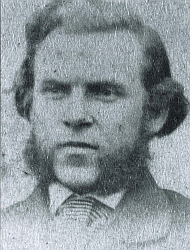
Owen Hargrave Suffolk was an Australian bushranger, poet, confidence-man and author of Days of Crime and Years of Suffering (1867).

Satana Hellstrom is a fictional character appearing in American comic books published by Marvel Comics. Created by Roy Thomas and John Romita Sr., she first appeared in Vampire Tales #2. Satana belongs to the species of magical beings called demons, who are born with supernatural abilities, as a human-demon hybrid. She is the younger sister of Daimon Hellstrom and the daughter of Marduk Kurios.

The black dog is a supernatural, spectral, or demonic hellhound originating from English folklore that has also been seen throughout Europe and the Americas. It is usually unnaturally large with glowing red or yellow eyes, is often connected with the Devil, and is sometimes an omen of death. It is sometimes associated with electrical storms, and also with crossroads, barrows, places of execution and ancient pathways.
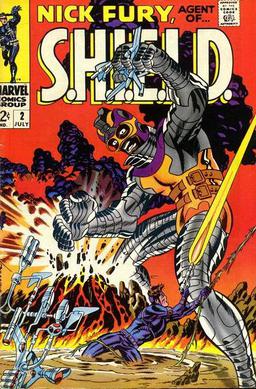
Centurius is a fictional supervillain appearing in American comic books published by Marvel Comics. Debuting in 1968, he was Marvel's first black supervillain.
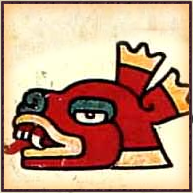
Dogs have occupied a powerful place in Mesoamerican folklore and myth since at least the Classic Period right through to modern times. A common belief across the Mesoamerican region is that a dog carries the newly deceased across a body of water in the afterlife. Dogs appear in underworld scenes painted on Maya pottery dating to the Classic Period and even earlier than this, in the Preclassic, the people of Chupícuaro buried dogs with the dead. In the great Classic Period metropolis of Teotihuacan, 14 human bodies were deposited in a cave, most of them children, together with the bodies of three dogs to guide them on their path to the underworld.

The Headless Horseman is a mythical figure who has appeared in folklore around Europe since the Middle Ages. The figure is traditionally depicted as a rider upon horseback who is missing his head.
The Cheltenham Ghost was an apparition said to haunt a house in Cheltenham in western England. The building in Pittville Circus Road was the home of the Despard family who saw the ghost of a veiled woman on several occasions in the 1880s.
Luke Hutton was an English criminal and reputed author.














